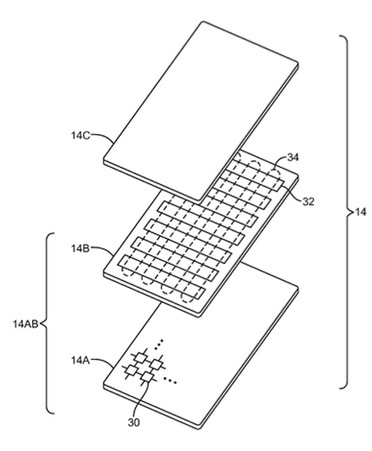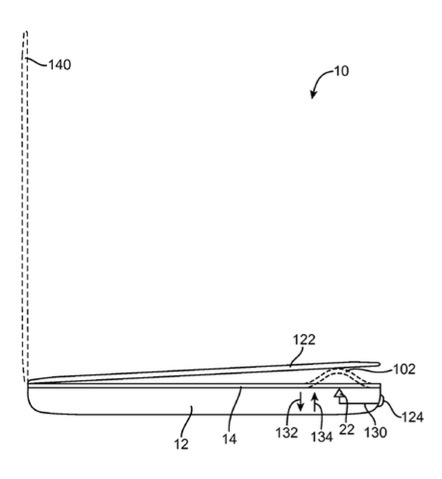An Apple patent (number 2012042592 for an electronic device with flexible displays has appeared at the U.S. Patent & Trademark Office. We may be looking at future iPhones and iPads -- perhaps even Macs -- with "bendable" screens and tactile keyboards.
Per the patent electronic devices may be provided that contain flexible displays and internal components. An internal component may be positioned under the flexible display. The internal component may be an output device such as a speaker that transmits sound through the flexible display or an actuator that deforms the display in a way that is sensed by a user.
The internal component may also be a microphone or pressure sensor that receives sound or pressure information through the flexible display. Structural components may be used to permanently or temporarily deform the flexible display to provide tactile feedback to a user of the device.
Here's Apple's background and summary of the invention: "This relates generally to flexible displays, and more particularly, to electronic devices with flexible displays. Electronic devices such as portable computers and cellular telephones are often provided with rigid displays made from rigid display structures. For example, a liquid crystal display (LCD) may be formed from a stack of rigid display structures such as a thin-film transistor layer with display pixels for providing visual feedback to a user, a color filter layer for providing the display pixels with color, a touch screen panel for gathering touch input from a user, and a cover glass layer for protecting the display and internal components.
"Conventional devices may also have input-output components such as buttons, microphones, speakers, and other components. Openings are commonly formed in the housing of a conventional device to accommodate operation of these input-output components. For example, openings may be formed in a device housing to accommodate speaker and microphone ports and openings may be formed in a display cover glass layer to accommodate a speaker port and menu button.
"The inclusion of these openings to accommodate input-output components may not be desirable. For example, the presence of openings may be aesthetically unappealing, may raise the risk of damage from environmental exposure, and may reduce the amount of active display area that is available to display images for a user. It would therefore be desirable to be able to provide improved electronic devices.
"Electronic devices may be provided with flexible displays. The flexible displays may be composed of one or more flexible layers and may be mounted on top of or under a cover layer. For example, a flexible display may be mounted on top of a rigid support member or may be mounted on the underside of a rigid cover layer.
"Electronic devices may also be provided with user interface components (input-output components) such as buttons, microphones, speakers, piezoelectric actuators (for receiving electrical input from a user or tactile feedback to users), or other actuators such as vibrators, pressure sensors, and other components. These components may be mounted under portions of a flexible display.
"During operation of the electronic device, the flexibility of the display may allow a user to interact with the component through the display. For example, sound waves from a speaker or localized vibrations from an actuator in an electronic device may pass through the flexible display. The flexible display may also allow an internal microphone, pressure sensor, or force sensor (or other internal components) to receive external input. For example, a user may deflect a flexible display using a finger or other external object, barometric pressure may be monitored through the flexible display, or sound waves may be received through the flexible display.
"Components may receive input or may supply output through a physically deformed portion of the flexible display (e.g., a deformation that occurs when a user presses on the display to compress the component). In some configurations, a portion of the flexible display may serve as a membrane that forms part of a microphone, speaker, pressure sensor, or other electronic component.
"The ability of a user to compress a component such as a button switch by deforming the flexible display may allow the area of a device available for visual display to be enlarged. For example, the active area of a flexible display may overlap a component such as a button or speaker.
"If desired, a flexible display may be deformed by an internal component to provide audio or tactile feedback to a user. For example, structures inside an electronic device may be pressed against portions of a flexible display to temporarily create an outline for a virtual on-screen button or to temporarily create a grid of ridges that serve to delineate the locations of keys in a keyboard (keypad).
"Further features of the invention, its nature and various advantages will be more apparent from the accompanying drawings and the following detailed description of the preferred embodiments."
The inventors are Fletcher R. Rothkopf, Scott A. Myers and Stephen Brian Lynch.














